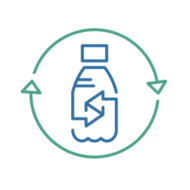You’ve seen them, but do you know what they mean?
What Are Eco Labels?
Eco labels are a form of sustainability measurement that help consumers guage the sustainability of a product. They are represented as small seals and are usually found around the edges of products.
There are over 460 eco labels, but only a handful are relevant to our everyday shopping.
What You Should Know
Knowing the basic eco labels is one of the easiest ways to support responsible brands and lower your personal environmental impact. In the highly competitive world of product labeling, there is a lot of deception. Luckily there are a few trustworthy labels you can look for that give you some security about the quality of the product inside.
To help you navigate products in the supermarket, Habit #4 is to know the main eco labels and look for them when shopping.
This post is only going to cover the main eco labels for items typically found in the supermarket. There are also eco labels for electronics and other products we buy less frequently and you can read about some of those in my in-depth piece about eco labels.
Note: You need to know that there are many fake eco labels out there that use loose verbiage and made up stamps of approval to try to win your business. I’ll cover this more in tip #5 greenwashing, but for now just be aware that you can’t trust everything that looks like an eco label.
Here are the main eco labels to look for:
Fair Trade
If a product has any of these eco labels it means they have been audited and approved for fair labor practices by a third party. Each eco label has slightly different standards but they all signify that the certified product has been produced under fair labor conditions.
Fair trade eco labels are most common on coffee and tea products which have a notorious history of exploitation, but they are starting to branch out and can now be found on bananas and some cotton products.
Organic
The USDA Organic eco label is issued by the US Department of Agriculture and it’s one of the most prevalent eco labels. While it isn’t perfect, the USDA standards prohibit the use of synthetic fertilizers and pesticides, antibiotics, GMOs, and more. You can count on these products being more sustainable and in general higher quality.
Others
Rainforest Certified – The Rainforest Alliance eco label certifies products that originate on or have ingredients that come from a farm or forest operation. The certification criteria for the label is designed to conserve wildlife, safeguard soils and waterways, protect workers and their communities, and support long-term sustainability.
This eco label can be found on coffee, chocolate, tea, fruit, flowers, paper products, furniture, and even on some tourism lodges.
Marine Stewardship Council (MSC) – The MSC certification seeks to approve seafood that comes from sustainable fish stocks and that was harvested in a way that minimally impacts the environment. If you like to eat fish but are concerned about your impact, this is good one to keep an eye out for.
See more seafood eco labels here.
Your Action Item:
Just getting started:
If you’re new to eco labels, start looking a bit closer at products and identify these main eco labels. If you have specific areas of concern such as animal welfare, you can research the right eco labels to look for (like Leaping Bunny). I’ve provided a few resources to help you get started in the resources section below.
Advanced conscious consumers:
If you’re already pretty well informed about eco labels, double check to make sure you aren’t getting duped by some of the lesser-known “eco-labels”. Many brands will use fake eco labels and misleading verbiage to gain your trust. If you are unsure of an eco label, do your research and let me know what you find so I can share it with the group!
Want to learn more? Join the club:
[mc4wp_form id=”747″]
Resources:
In this post I dig a bit deeper into eco labels, including labels for electronics and the B Corp eco label.
Consumer Reports offers some helpful information about eco labels on food products in their Greener Choices initiative. This site will help you understand the value of eco labels commonly seen on food packaging.
If you find an eco label and you’re not sure what it means, you can look it up here. This has just about every eco label and offers a brief explanation on each. If you search an eco label and don’t find it here, it’s probably phony.




